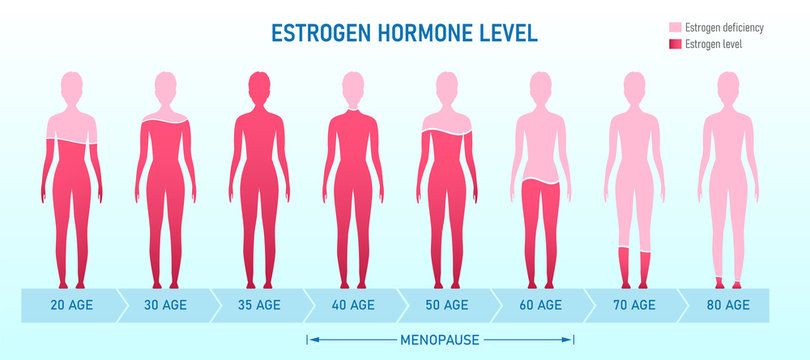Menopause marks a significant transition in a woman's life, not just for the traditional cessation of menstrual periods but also for its profound effects on various physiological functions, including skin health. My commitment is to advocate for and educate you on these changes, focusing on how the decline in estrogen levels impacts skin appearance, health, and overall wellness. While you might wonder, 'What does she know? She's so young,' understanding the profound changes menopause brings to a woman's life is part of my expertise and training as family nurse practitioner, integrative health and dermatology. Drawing upon the vast amount of women I see looking for solutions, let's explore the intricate relationship between estrogen and skin health during menopause and solutions you can do at home to manage these changes.
The Vital Role of Estrogen in Skin Health
Estrogen, particularly 17β-estradiol, plays a crucial role in maintaining skin integrity and function. This hormone, produced by the ovaries and other peripheral tissues, acts through estrogen receptors to regulate a myriad of biological functions crucial for skin health. As women approach menopause, the production of estrogen significantly decreases, leading to a range of skin-related issues.

Key Changes in Menopausal Skin:
- Loss of Collagen and Elastin: The reduction in estrogen levels results in diminished collagen and elastin production, leading to thinner, less elastic skin, wrinkles, fine lines, etc.
- Decreased Vascularity: Reduced estrogen also affects skin vascularity, leading to poorer circulation and, consequently, less nutrient-rich blood reaching the skin.
- Increased Dryness and Wrinkles: With lower hydration levels and decreased sebum production, the skin becomes drier, and wrinkles become more pronounced.
- Impaired Wound Healing: Estrogen deficiency slows down the skin's healing processes, making recovery from injuries longer.
- Decreased Antioxidant Capacity: The skin's ability to defend against oxidative stress and reactive oxygen species diminishes, making it more prone to damage.

Diagnosing Low Estrogen
First off, if you're noticing changes that might be related to low estrogen, such as irregular periods or mood swings, it's a good idea to chat with a healthcare professional you trust. They'll look at your family and medical history, check your current symptoms, and might run some tests, like checking your hormone levels, to see what's going on. Sometimes, if you're over 45 and showing signs of menopause, detailed hormone tests might not even be needed.
Navigating Menopausal Skin Changes: Strategies for Management
Understanding the impact of menopause on skin health is the first step toward effective management. Here are some strategies to help mitigate the effects of estrogen deficiency on the skin:
- Selective Estrogen Receptor Modulators (SERMs), have shown promise in that they are phytoestrogens found in plant-based compounds, that can offer an option for treating menopausal skin changes. These agents mimic estrogen's beneficial effects on the skin.
- Skincare Ingredients to Look For: When choosing skincare products, focus on those containing hydrating ingredients like hyaluronic acid, which helps retain water in the skin, making it look plump and awake. Antioxidants, such as vitamin C, protect the skin from damage caused by free radicals, while superoxide dismutase is a powerful enzyme that helps break down potentially harmful oxygen molecules in cells, preventing damage to tissues. Retinol, a form of vitamin A, promotes skin renewal and collagen production, helping to reduce the appearance of wrinkles.
- Natural Supplements and Diet: Eating foods rich in antioxidants (like berries, nuts, and green leafy vegetables) and taking supplements can make a big difference. Eating foods rich in phytoestrogens, like flax seeds, soybeans, and berries, can naturally boost estrogen levels. Focusing on healthy fats, proteins, and a variety of fruits and vegetables can also support hormone health. Supplements such as vitamin E, omega-3 fatty acids, Vitamin D, probiotics, magnesium, DHEA, and evening primrose oil can also support skin health by improving hydration and reducing inflammation.
- Healthy Habits: Keeping active with regular exercise, staying hydrated, and protecting your skin from too much sun are all essential practices. These habits help maintain your skin's elasticity and vitality from the inside out.
- Seeking Expert Advice: Sometimes, it's best to get personalized care. Talking to a dermatologist, OBGYN, Endocrinologist or even a specialist is the way to go if you're really concerned about your estrogen levels. That way you can get the proper medical interventions if need be. And I am always available for the preventive care and skin treatments!

Menopause signifies a pivotal phase in a woman's life, bringing about changes that extend beyond mere reproductive functions. The skin, being the largest organ, visibly manifests these hormonal shifts, often leading to concerns over appearance and wellness. However, with informed care, including the strategic use of skincare, lifestyle modifications, and professional advice, women can navigate these changes effectively, maintaining healthy, vibrant skin through menopause and beyond. Remember we are not about "Anti-Aging" anything, we are PRO aging and PRO health. Optimize your health!
Questions, thoughts? Leave below
References:
